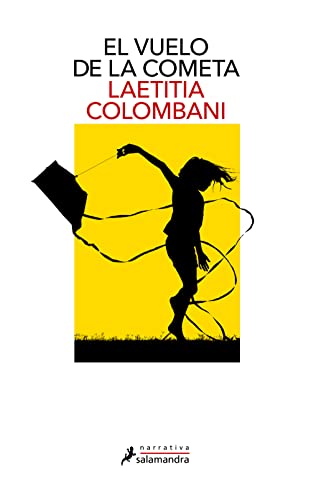Do you know when you decide "this is going to be my favorite song"? Well, something like this happens when you finish a book of laetitia colombani. Then time passes and new books dazzle you, as new songs become soundtracks of life. But the question is how a reading or an audition won you in that moment treasured in the memory.
Perhaps it is a kind of translation of the cinematographic activity of this author to literature. The point is that his novels move like meticulously visualized scenes, not scripted but stamped in an all-dimensional mosaic that introduces us to a complex notion of existing with every pain, with every drive or passion, with every weakness or every hope that breaks through. to each new day.
And of course when something breaks out with that unusual freshness, with the originality of knowing how to give realism the necessary wings towards illusion and hope, devoted readers multiply in unstoppable progression.
Best novels by Laetitia Colombani
The flight of the kite
There are images par excellence that make up a common imaginary. The kite that directs its unpredictable flight between currents on the beach. Like the very evolution of life that seems to lead us by a firm thread but at the same time subjected to ups and downs, gusts, unexpected turns. On this occasion the image takes the form of a girl who finds in the flight of her kite her only childhood moment, her surrender to a stolen time….
After the drama that has blown up her existence, Léna decides to leave everything behind and set out on a trip to the Bay of Bengal. Haunted by the ghosts of the past, she does not find a bit of peace until, at dawn, she goes to swim in the waters of the Indian Ocean, where a girl plays with a kite every morning.
One day, on the verge of drowning in the current, Léna miraculously survives thanks to the warning from the little girl and the intervention of the Red Brigade, a female self-defense group that trained nearby. Grateful, she gets in touch with the girl and discovers that she works tirelessly in a restaurant. He has never been to school and has shut himself up in absolute silence. What hides its silence? What is its history?
The braid
It was enviable to see how a mother or a friend was immersed in the task of weaving a braid with the hair of the girl on duty. An exercise that the writer observed with that strange taste for things as beautiful as they are known to be perishable.
It was something very feminine and tribal. While the braid came to life, the women talked about their things, as if extending the touch to other links of communication. The hair as a connection port through which information inaccessible to the rest moves.
This braid is brought together by the very different lives of women from here and there, from all over planet Earth. The connection stems from the analogy of the feminine in the face of materialized adversity in any context.
INDIA. In Badlapur, the untouchable Smita survives by collecting the droppings of a higher caste. Resigned to her condition, she is determined instead that her daughter does not follow in her footsteps: the little girl will go to school and her life will be worthy and profitable, even though Smita has to defy the established norms to do so.
ITALY. Giulia loves working in the family workshop, the last in Palermo that makes wigs with real hair. He could have gone to college, but he left high school at the age of sixteen to learn the secrets of this trade. When her father suffers an accident and Giulia discovers that the business is on the brink of bankruptcy, she faces adversity with courage and determination.
CANADA. Sarah is a successful Montreal attorney who has sacrificed everything for her career: two failed marriages and three children she hasn't seen grow up. One day, after falling unconscious during a trial, Sarah realizes that her life has turned upside down and that she will have to choose what really matters to her.
Smita, Giulia and Sarah do not know each other, but they have in common the drive and tenacity of women who reject what fate has in store for them and rebel against the circumstances that oppress them. Like invisible threads, their paths intertwine, forming a braid that symbolizes the unshakable will to live with hope and illusion.
The victors
Every battle involves a thousand forms of victory, from the most Pyrrhic to the most glorious. And it does not have to correspond to the highest general recognition or the most notorious a priori significance.
In the end, the detail and the apparently anecdotal transcend the human and serve the cause of evolution. The deeds are archived if they do not burn in some new historical moment. The most relevant victories are those that can be rescued from memory, from the small example and the learning that becomes great. A hymn to solidarity and hope where Colombani gives voice to the anonymous winners of history.
At the age of forty, Solène has sacrificed everything for her career as a lawyer: her dreams, her friends and her loves, until one day she collapses and falls into a deep depression. To help you recover, your doctor advises you to volunteer. Unconvinced, Solène finds an ad online that arouses her curiosity and decides to take an interest in it.
Sent to a home for women at serious risk of social exclusion, she has problems relating to the residents, who are distant and elusive; but little by little you will gain their confidence and discover to what extent you want to be as alive as they are.
A century earlier, Blanche Peyron fights a fight. Commander of the Salvation Army in France, he has the dream of offering a roof to all those excluded from society. With that end, in 1925 he began to raise the necessary funds to buy a monumental hotel, and a year later the Women's Palace opened its doors.
The Palace of Women exists and The victors invites us to enter it to discover the harsh reality of its inhabitants. With the same style of The braid, Laetitia Colombani embroiders an emotional song to the strength of women that speaks to us of loss and suffering, of goodness and brotherhood, that seduces us by its empathy and brings us vividly closer to the tragic existence of those invisible people to society.



